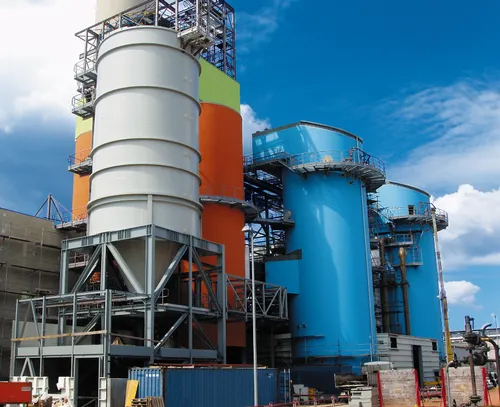Flue Gas Desulfurization
Flue gas desulfurization (FGD) is a technology used to remove sulfur dioxide (SO2) from the exhaust flue gases of fossil fuel power plants. Sulfur dioxide is a major contributor to acid rain, and its removal from power plant emissions is an important environmental objective.
There are several methods of FGD, but the most commonly used method is wet scrubbing. Wet scrubbing involves spraying a slurry of limestone or lime into the flue gas stream, which reacts with the sulfur dioxide to form calcium sulfate or calcium sulfite. The resulting solid waste is then disposed of in landfills or used in construction materials.
Another method of FGD is dry scrubbing, which involves injecting an alkaline material, such as sodium bicarbonate or trona, into the flue gas stream. The alkaline material reacts with the sulfur dioxide to form a solid waste that can be disposed of in the same manner as the waste from wet scrubbing.
Overall, FGD is an effective way to reduce the emission of sulfur dioxide from power plants and improve air quality. However, it can be expensive to implement and maintain, and the disposal of the resulting solid waste can also be an issue.
How to Treat Flue Gas Desulfurization
Flue gas desulfurization (FGD) systems require regular maintenance and treatment to ensure they function effectively and efficiently. Here are some common treatments for FGD:
1. Chemical Treatment: Chemical treatment involves adding chemicals to the scrubbing process to enhance the absorption of sulfur dioxide. For example, adding magnesium oxide can increase the efficiency of the process by up to 10%.
2. Physical Treatment: Physical treatment involves modifying the scrubber design to improve the contact between the flue gas and the scrubbing solution. This can be achieved by increasing the surface area of the scrubber or by improving the spray pattern of the scrubbing solution.
3. Biological Treatment: Biological treatment involves using microorganisms to convert the sulfur dioxide into elemental sulfur or sulfates. This can be achieved by adding bacteria or fungi to the scrubbing solution or by using biofilters to remove the sulfur dioxide from the flue gas.
4. Maintenance: Regular maintenance of FGD systems is important to ensure they function effectively. This includes inspecting and cleaning the scrubber nozzles, monitoring the pH levels of the scrubbing solution, and replacing worn or damaged components.
5. Waste Treatment: The solid waste generated from FGD systems must be treated and disposed of properly. This can involve dewatering, drying, and stabilizing the waste before it is disposed of in a landfill or used in construction materials.
Overall, proper treatment of FGD systems is essential to ensure they function effectively and efficiently, and to minimize their impact on the environment.
Flue gas desulfurization (FGD) is a process used to remove sulfur dioxide (SO2) from the flue gas emissions of fossil fuel combustion. Here's how FGD works:
1. Flue Gas Scrubbing: The first step in FGD is to scrub the flue gas with a scrubbing solution. The scrubbing solution is typically a slurry of limestone or lime in water, but other chemicals can also be used. The scrubbing solution is sprayed into the flue gas stream, which is then directed through a large chamber called a scrubber
2. Absorption of SO2: As the flue gas passes through the scrubber, the sulfur dioxide in the gas reacts with the scrubbing solution to form calcium sulfate or calcium sulfite. The chemical reaction takes place through a series of complex chemical reactions that involve the neutralization of the acidic gas by the alkaline scrubbing solution.
3. Separation of Solid Waste: The resulting solid waste from the scrubber, which is a mixture of calcium sulfate and calcium sulfite, is then separated from the scrubbing solution. The solid waste can then be disposed of in landfills or used in construction materials.
4. Regeneration of Scrubbing Solution: The scrubbing solution can be regenerated by adding chemicals such as magnesium oxide or sodium carbonate, which react with the calcium sulfate or calcium sulfite to form gypsum or sodium sulfate, respectively. The regenerated scrubbing solution can then be reused in the scrubbing process.
5. Disposal of Waste: The waste products of FGD, such as gypsum or sodium sulfate, can be reused or disposed of properly. Proper disposal of the waste products is important to avoid potential environmental impacts.
Overall, FGD is an effective way to reduce sulfur dioxide emissions and improve air quality. The technology has been widely adopted in power generation and industrial processes that produce SO2 emissions.
Flue Gas Desulfurization Application
Flue gas desulfurization (FGD) is widely used in power plants and other industrial facilities to reduce sulfur dioxide (SO2) emissions from the combustion of fossil fuels. Here are some common applications of FGD:
1. Coal-Fired Power Plants: Coal-fired power plants are one of the main sources of SO2 emissions. FGD is used to remove the sulfur dioxide from the flue gas before it is released into the atmosphere. The majority of coal-fired power plants in the United States have FGD systems installed.
2. Oil-Fired Power Plants: Oil-fired power plants also produce sulfur dioxide emissions. FGD can be used to reduce these emissions by up to 95%.
2. Oil-Fired Power Plants: Oil-fired power plants also produce sulfur dioxide emissions. FGD can be used to reduce these emissions by up to 95%.
4. Cement Plants: Cement production also produces sulfur dioxide emissions. FGD can be used to reduce these emissions and improve air quality.
5. Waste Incinerators: Waste incineration also produces sulfur dioxide emissions. FGD can be used to reduce these emissions and ensure compliance with environmental regulations.
Overall, FGD is an effective technology for reducing sulfur dioxide emissions and improving air quality. Its applications are widespread in power generation and various industrial processes that produce SO2 emissions.
Features
We have provided numerous FGD plants across the globe and have increased our market share by providing the following features :
satisfying specified emission requirements for various types of fossil fuels with high SO2 removal efficiency
device for multiple pollutant management and related environmental control
High dependability
savings on utilities and energy

